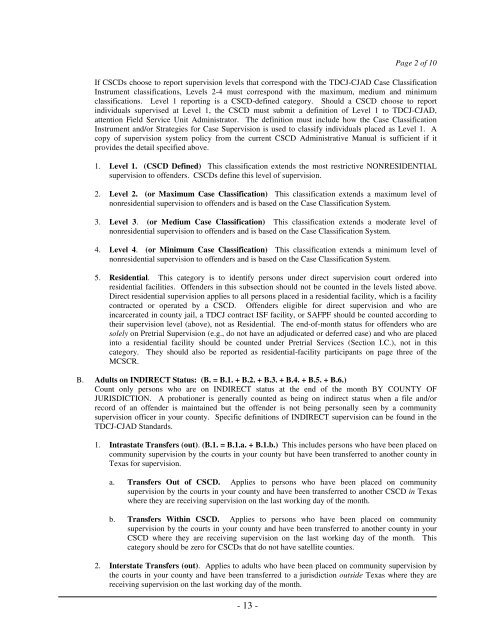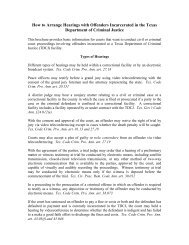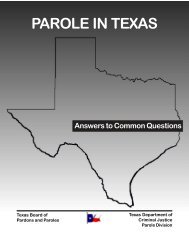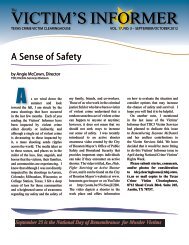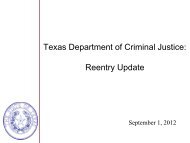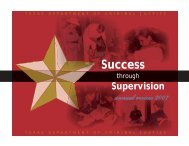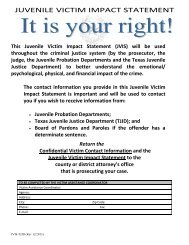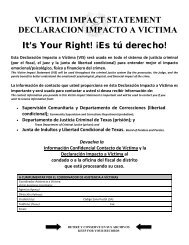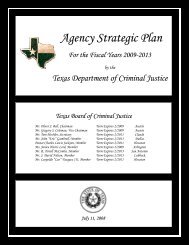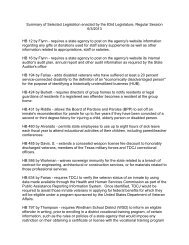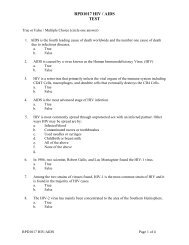TDCJ-CJAD Data Manual - Texas Department of Criminal Justice
TDCJ-CJAD Data Manual - Texas Department of Criminal Justice
TDCJ-CJAD Data Manual - Texas Department of Criminal Justice
You also want an ePaper? Increase the reach of your titles
YUMPU automatically turns print PDFs into web optimized ePapers that Google loves.
Page 2 <strong>of</strong> 10If CSCDs choose to report supervision levels that correspond with the <strong>TDCJ</strong>-<strong>CJAD</strong> Case ClassificationInstrument classifications, Levels 2-4 must correspond with the maximum, medium and minimumclassifications. Level 1 reporting is a CSCD-defined category. Should a CSCD choose to reportindividuals supervised at Level 1, the CSCD must submit a definition <strong>of</strong> Level 1 to <strong>TDCJ</strong>-<strong>CJAD</strong>,attention Field Service Unit Administrator. The definition must include how the Case ClassificationInstrument and/or Strategies for Case Supervision is used to classify individuals placed as Level 1. Acopy <strong>of</strong> supervision system policy from the current CSCD Administrative <strong>Manual</strong> is sufficient if itprovides the detail specified above.1. Level 1. (CSCD Defined) This classification extends the most restrictive NONRESIDENTIALsupervision to <strong>of</strong>fenders. CSCDs define this level <strong>of</strong> supervision.2. Level 2. (or Maximum Case Classification) This classification extends a maximum level <strong>of</strong>nonresidential supervision to <strong>of</strong>fenders and is based on the Case Classification System.3. Level 3. (or Medium Case Classification) This classification extends a moderate level <strong>of</strong>nonresidential supervision to <strong>of</strong>fenders and is based on the Case Classification System.4. Level 4. (or Minimum Case Classification) This classification extends a minimum level <strong>of</strong>nonresidential supervision to <strong>of</strong>fenders and is based on the Case Classification System.5. Residential. This category is to identify persons under direct supervision court ordered intoresidential facilities. Offenders in this subsection should not be counted in the levels listed above.Direct residential supervision applies to all persons placed in a residential facility, which is a facilitycontracted or operated by a CSCD. Offenders eligible for direct supervision and who areincarcerated in county jail, a <strong>TDCJ</strong> contract ISF facility, or SAFPF should be counted according totheir supervision level (above), not as Residential. The end-<strong>of</strong>-month status for <strong>of</strong>fenders who aresolely on Pretrial Supervision (e.g., do not have an adjudicated or deferred case) and who are placedinto a residential facility should be counted under Pretrial Services (Section I.C.), not in thiscategory. They should also be reported as residential-facility participants on page three <strong>of</strong> theMCSCR.B. Adults on INDIRECT Status: (B. = B.1. + B.2. + B.3. + B.4. + B.5. + B.6.)Count only persons who are on INDIRECT status at the end <strong>of</strong> the month BY COUNTY OFJURISDICTION. A probationer is generally counted as being on indirect status when a file and/orrecord <strong>of</strong> an <strong>of</strong>fender is maintained but the <strong>of</strong>fender is not being personally seen by a communitysupervision <strong>of</strong>ficer in your county. Specific definitions <strong>of</strong> INDIRECT supervision can be found in the<strong>TDCJ</strong>-<strong>CJAD</strong> Standards.1. Intrastate Transfers (out). (B.1. = B.1.a. + B.1.b.) This includes persons who have been placed oncommunity supervision by the courts in your county but have been transferred to another county in<strong>Texas</strong> for supervision.a. Transfers Out <strong>of</strong> CSCD. Applies to persons who have been placed on communitysupervision by the courts in your county and have been transferred to another CSCD in <strong>Texas</strong>where they are receiving supervision on the last working day <strong>of</strong> the month.b. Transfers Within CSCD. Applies to persons who have been placed on communitysupervision by the courts in your county and have been transferred to another county in yourCSCD where they are receiving supervision on the last working day <strong>of</strong> the month. Thiscategory should be zero for CSCDs that do not have satellite counties.2. Interstate Transfers (out). Applies to adults who have been placed on community supervision bythe courts in your county and have been transferred to a jurisdiction outside <strong>Texas</strong> where they arereceiving supervision on the last working day <strong>of</strong> the month.- 13


